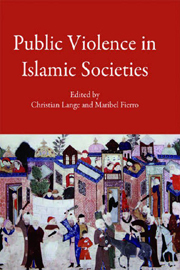 Public Violence in Islamic Societies
Public Violence in Islamic Societies Book contents
- Frontmatter
- Contents
- List of abbreviations
- Acknowledgements
- Introduction: Spatial, ritual and representational aspects of public violence in Islamic societies (7th–19th centuries ce)
- PART I Public violence and the construction of the public sphere
- PART II Ritual dimensions of violence
- PART III Representations of public violence
- 9 Responses to crucifixion in the Islamic world (1st–7th/7th–13th centuries)
- 10 Violence and the prince: the case of the Aghlabid Amīr Ibrāhīm II (261–89/875–902)
- 11 Concepts of justice and the catalogue of punishments under the Sultans of Delhi (7th–8th/13th–14th centuries)
- 12 Public violence, state legitimacy: the Iqāmat al-ḥudūd and the sacred state
- 13 Violence in Islamic societies through the eyes of non-Muslim travellers: Morocco in the 19th and early 20th centuries
- Index
9 - Responses to crucifixion in the Islamic world (1st–7th/7th–13th centuries)
from PART III - Representations of public violence
Published online by Cambridge University Press: 12 September 2012
- Frontmatter
- Contents
- List of abbreviations
- Acknowledgements
- Introduction: Spatial, ritual and representational aspects of public violence in Islamic societies (7th–19th centuries ce)
- PART I Public violence and the construction of the public sphere
- PART II Ritual dimensions of violence
- PART III Representations of public violence
- 9 Responses to crucifixion in the Islamic world (1st–7th/7th–13th centuries)
- 10 Violence and the prince: the case of the Aghlabid Amīr Ibrāhīm II (261–89/875–902)
- 11 Concepts of justice and the catalogue of punishments under the Sultans of Delhi (7th–8th/13th–14th centuries)
- 12 Public violence, state legitimacy: the Iqāmat al-ḥudūd and the sacred state
- 13 Violence in Islamic societies through the eyes of non-Muslim travellers: Morocco in the 19th and early 20th centuries
- Index
Summary
The first longer treatment of crucifixion as a punishment in the Islamic world in a European language was a contribution by Otto Spies to the Festschrift für Gustav Mensching in 1967, bearing the title “Über die Kreuzigung im Islam” (“On crucifixion in Islam”). Spies's article treats the background of the punishment in the Qurɔān, prophetic tradition (ḥadīth) and the books of Muslim jurists and then presents a long list of reports about crucifixions in the Arabic historical, biographical and narrative literature. Nine years later, Hellmut Ritter's short article “Kreuzigung eines Knaben” (“Crucifixion of a young boy”) was published posthumously by Rudolf Sellheim. The article mainly consists of a translation of a report in Abū Shāma's (d. 665/1268) al-Dhayl calā al-rawḍatayn about a young Turkish slave who was nailed to the cross alive in Damascus in 646/1248. The slave allegedly had killed his master. From a remark of Abū Shāma and a line of poetry quoted by him one gets the impression that the slave had had to defend himself from sexual harassment on his master's part. Abū Shāma describes the young man's death, stretching over two days, in detail and with subtle sympathy for the offender. The impact of Abu Shāma's prose is so strong that even a modern reader will find it difficult to read the Arabic original (or, for that matter, the German translation by Ritter) through to the end.
My contribution deals with some comparable texts containing information on how crucifixion as a punishment or method of deterrence was perceived by contemporaries.
- Type
- Chapter
- Information
- Public Violence in Islamic SocietiesPower, Discipline, and the Construction of the Public Sphere, 7th-19th Centuries CE, pp. 203 - 216Publisher: Edinburgh University PressPrint publication year: 2009


